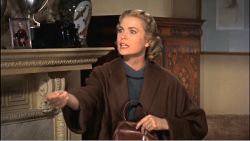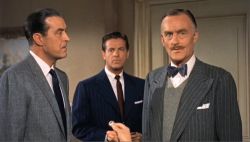The MacGuffin: News and Comment (15/Sep/2012)
(c) Ken Mogg (2012)
Sep 15
On our 'advanced' Hitchcock discussion group this week I recommended David Bordwell's latest blog, about Hitchcock's Dial M for Murder (1954). I hadn't actually read the piece at the time, but I knew that our members would appreciate it. My own reaction, though, proved to be mixed. I know I'm not alone when I sometimes find Bordwell to be too much the dry, formalist analyser of film - I can't imagine him satisfactorily treating, say, Hitchcock's compassion (in all its ambiguity and detachment ...). But specifically, in his Dial M piece, Bordwell isn't even especially insightful about Hitchcock's canniness, although he certainly presents himself as being that. Hmm. Clearly I should qualify what I've just said! First, I still highly recommend Bordwell's piece (it's here). Second, Professor Bordwell is a friend of a friend, and I've not the slightest doubt that he's a most pleasant guy - just as I've heard that Slavoj Zizek is the sort of guy you'd like to be drinking with if you found yourself snowed in for a few days! But now, that said, I want to consider the item with which Bordwell opens and closes his piece, the moment in the film when Margot (Grace Kelly) in effect protests her innocence by holding out her latchkey (see the two frame-captures below). She holds the key towards the left of frame and then, in a reverse-shot, we see husband Tony, (boy)friend Mark, and Inspector Hubbard, reacting. Margot's hand now occupies the bottom centre of the frame. Bordwell comments: 'This cut makes you say: Huh? Margot’s hand is shamelessly out of proportion and, judging by the men’s stares, we’re somehow looking through her torso.' And he suggests that he - Bordwell - 'can still be shocked by the old guy's [Hitchcock's] sheer bravado'. (Hitchcock was 55 at the time.) But why, exactly? For one thing, Margot's hand holding the key in the reaction-shot is now centre of frame rather than left or right of it because, after all, the key is the thing. Also, it is in fact correctly shown in alignment with Margot's line of vision and, besides, looks about the right size to me. (We're all used to how wide-angle lenses in pov shots can distort perspective by foreshortening, which is something Hitchcock has largely avoided here.) But that's not all. Note next how each of the three men, reacting, is caught looking anywhere but directly at the key. Tony is - understandably - looking at Hubbard, Mark - the lover - in the background is looking in Margot's general direction, and Hubbard is looking - literally - askance. This shot has been absolutely thought out by Hitchcock, and is subjectively right. But there's still more. Hitchcock often used the phrase, 'taking the curse off'. If those men were shown all looking directly at Margot and/or at the key she is (supposedly) holding out, the effect would be, at best, obvious, and might even border on the comic. ('That's snapped all those guys to attention, hasn't it!') Yet, as I say, the subjective effect for the audience is in fact absolutely right. By its almost imperceptible 'wrong match' with what we might have expected, it implants and emphasises the idea of how Margot is having to contend with a lack of credibility and that she is now very vulnerable ... Okay. Today I want to comment on just one other thing in Bordwell's piece. A couple of times he notes shots which don't do the 'obvious' thing (a long-shot of Tony slipping the key under the stair carpet, without a close-up; a medium-shot of Tony indicating where he'll slip the key under the said stair-carpet, again without a close-up). What Bordwell doesn't note - although he's of course right in saying that Hitchcock respects our intelligence - is that in both cases the view is from the general pov of a watching third party - Mark, Swann - and that this fact determines why there's no close-up. (Both times, the watching third party's head is just visible in the corner of the shot.) In the first case, Mark isn't even aware of what Tony is doing (but we are); in the second, Swann gets the general idea without any pedantic dwelling on which particular step is involved (and we'll find later that he wasn't necessarily going to follow Tony's exact directions anyway). Also, Hitchcock is saving up the close-up for later ... Bordwell's piece with its multiple frame-captures is very helpful in noting specific recurring shots that mark key points in Tony's murder plan (e.g., Margot's exiting the bedroom to go to where the murder is to take place beside the phone in the living-room): these shots help us feel oriented as the complex plan unfolds (and then starts to go wrong). Finally, I especially appreciated Bordwell's true remark that by staying essentially on one set, and then allowing his camera to roam within it, Hitchcock gives us a result that 'feels both theatrical and cinematic - a concentrated stage piece heightened by the tools of cinema'. Enjoy the article!
This material is copyright of Ken Mogg and the Hitchcock Scholars/'MacGuffin' website (home page) and is archived with the permission of the copyright holder. |


